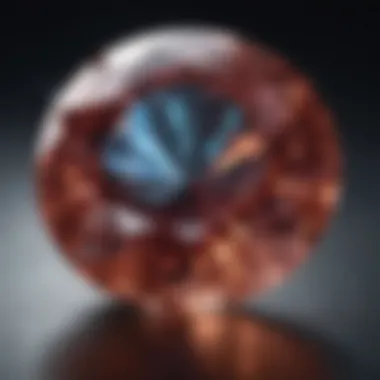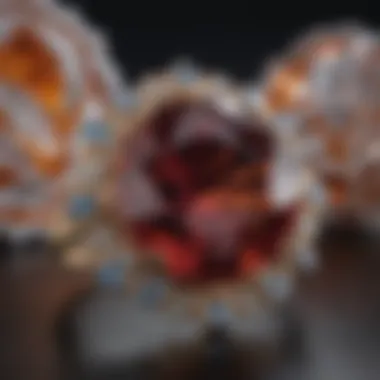Lab Grown Gemstone Jewelry: A Modern Perspective


Intro
The realm of gemstones has long fascinated humanity. From their dazzling beauty to their cultural significance, gemstones have held a special place in various societies throughout history. Recent advancements have led to the rise of lab grown gemstones, which have begun to reshape the landscape of the jewelry market. This article aims to provide insight into lab grown gemstone jewelry, offering an overview of its definition, unique characteristics, and implications for both consumers and professionals in the industry.
As our world becomes increasingly conscious of environmental impact and ethical sourcing, the shift towards lab grown gemstones represents a pivotal moment in jewelry. With their growing popularity, understanding the nuances and implications of these modern gems is essential.
Gemstone Overview
Definition and Characteristics
Lab grown gemstones, also known as synthetic or cultured gemstones, are created using modern technology to replicate the natural processes that form gemstones deep within the earth. Unlike their natural counterparts, these stones are engineered in controlled environments and can be produced in various colors, sizes, and qualities. The most prominent aspect of lab grown gemstones is that they share the same chemical composition and physical characteristics as mined stones, making them virtually indistinguishable to the untrained eye.
Some key characteristics include:
- Quality Consistency: Lab grown gemstones often exhibit fewer inclusions and greater clarity, contributing to their appeal.
- Environmental Benefits: These gemstones eliminate the need for destructive mining practices, thus preserving landscapes.
- Cost Efficiency: Generally, lab grown gemstones are priced lower than natural stones, making them more accessible to consumers.
Classification of Gemstones
Gemstones can be broadly classified into two categories: natural and lab grown. Within this framework, various types of gemstones exist based on their properties.
- Natural Gemstones: Formed through geological processes over millions of years. Examples include diamond, ruby, and sapphire.
- Lab Grown Gemstones: Created using techniques like hydrothermal and Czochralski methods, replicating the conditions of nature. For instance, lab grown diamonds and sapphires possess the same physical properties as naturally mined stones.
Historical Significance
Ancient Uses and Cultural Importance
Throughout history, gemstones have been revered for their beauty and perceived powers. In ancient cultures, gemstones were used in amulets, jewelry, and as currency. Many civilizations believed these stones held mystical properties, providing protection, health benefits, or even divine connections. For instance, Egyptians adorned themselves with lapis lazuli, while the Romans valued emeralds for their beauty and rarity.
Myths and Legends Surrounding Gemstones
Various myths and legends have arisen around gemstones, contributing to their allure. Consider the diamond, often associated with strength and invincibility. Folklore speaks of the power of sapphire to grant wisdom and protection. Such stories not only enriched cultural narratives but also influenced the demand for these gems.
In summary, the world of lab grown gemstones is evolving rapidly. With their growing significance in the modern market, it is essential to delve deeper into the technology that produces them and understand the ramifications for consumers and collectors alike.
Understanding Lab Grown Gemstones
Understanding lab grown gemstones is crucial in the current jewelry market. These stones challenge traditional notions of value and authenticity. By recognizing what lab grown gemstones are, buyers can make informed decisions. This section explores the definition, characteristics, and production processes of lab grown gemstones, providing insights that are relevant for both gemstone enthusiasts and professionals.
Definition and Characteristics
Lab grown gemstones, also known as synthetic or cultured gemstones, are stones that are created in controlled environments. The aim is to replicate the natural processes that form gemstones over millennia. These stones possess the same physical and chemical properties as their natural counterparts. One of the most significant characteristics is their consistency in quality and clarity. Unlike natural stones, which can have flaws, lab grown gems are often more perfect visually. Moreover, the process of creating them can be significantly less environmentally harmful.
Production Processes
The production of lab grown gemstones involves several methods, each with unique features and implications.
High Pressure High Temperature (HPHT)
The High Pressure High Temperature method mimics the conditions found deep within the Earth where natural diamonds form. This technique has become popular because it can produce stones that meet or exceed the quality of natural diamonds. HPHT diamonds exhibit specific inclusions that can sometimes help in their identification as lab created. The key characteristic of HPHT is its ability to produce high-quality stones in a shorter time than natural processes would require. However, one disadvantage can be the higher operational costs involved in maintaining the extreme conditions required for this method.
Czochralski Process
The Czochralski Process is another widely used method, particularly for creating gems like sapphires or rubies. In this method, a seed crystal is dipped into molten material then slowly pulled out. This allows for the formation of a large crystal as it cools. One key characteristic of the Czochralski Process is that it can produce larger gemstones with fewer defects compared to natural stones. However, it requires precision and control, which can introduce complexity and cost.
Hydrothermal Synthesis
Hydrothermal synthesis is a technique that involves using high-temperature and high-pressure systems to crystallize material from a solution. This method is often used for gemstones like emeralds and quartz. The key characteristic of hydrothermal synthesis is its ability to replicate natural conditions nearly identically, allowing for the growth of gemstones that look and feel natural. However, this process can take longer than others. Additionally, the cost may be a consideration for some producers.


Understanding these production processes is crucial for recognizing the distinct qualities of lab grown gemstones. By appreciating these intricacies, consumers can better evaluate the options available in the jewelry market.
Comparing Lab Grown and Natural Gemstones
The discussion surrounding lab grown and natural gemstones is of significant relevance in today's jewelry market. It encourages a thoughtful evaluation of how these stones compare across various dimensions. As consumers grow more discerning, understanding the distinctions becomes essential, not just for purchasing decisions but also for appreciating the implications of these two types of gemstones in terms of sustainability, ethics, and value.
Visual Qualities
When it comes to visual appeal, lab grown gemstones often closely mimic their natural counterparts. Both types can showcase vibrant colors and clarity, factors that are critical to their allure. However, slight differences can be observed under magnification.
For instance, natural stones may exhibit inclusions or irregularities formed over time, a characteristic often valued by collectors. In contrast, lab grown gemstones tend to have fewer visible flaws, creating a more uniform appearance.
- Color: Both types can vary in hue. Natural gems may change color due to light, while lab created alternatives often maintain a consistent shade.
- Clarity: Lab grown gems frequently achieve higher clarity levels, but this raises questions about authenticity and depth in visual character.
Physical Properties
From a scientific viewpoint, lab grown and natural gemstones can share similar physical properties such as hardness and refractive index. A gemstone's hardness, measured on the Mohs scale, determines its durability. For instance, diamonds, whether natural or lab grown, rate a perfect ten, signifying exceptional resilience.
However, laboratory processes can induce specific physical configurations that make lab stones unique.
- Durability: Both types possess excellent durability, yet lab gems often outperform natural ones in specific laboratory tests, leading to their increased desirability among jewelry designers.
- Weight: Lab grown gemstones may differ in weight from their natural similars due to differing production methods and inherent structures.
Value and Pricing
Considering the economic factors associated with gemstones, lab grown options often present distinct advantages. The initial cost of lab grown gemstones tends to be lower than that of natural stones. This stems from several aspects such as the production method and market demand. Natural gemstones involve extensive mining and processing, which can inflate their price tags.
- Market Stability: The pricing for natural gemstones can be volatile, subject to trends and rarity. Lab grown options, meanwhile, tend to offer greater affordability without compromising on beauty or quality.
- Resale Value: While lab grown stones are gaining popularity, their resale value is usually lower compared to natural gems. This is an important consideration for buyers aiming for long-term investment.
In summary, while both lab grown and natural gemstones possess appealing aspects, their comparison reveals significant distinctions in visual qualities, physical properties, and pricing structure. This understanding is uplifting for consumers as they make informed choices in a vibrant and evolving jewelry market.
"Understanding the differences between lab grown and natural gemstones allows consumers to make more informed choices that align with their values and needs."
By grasping these contrasts, enthusiasts can appreciate the multifaceted nature of gemstones in the modern era.
Market Trends in Lab Grown Gemstone Jewelry
The market for lab grown gemstone jewelry is evolving rapidly. This trend reflects not only technological advances but also a shifting consumer mindset. As awareness of sustainability increases, so too does interest in ethical practices. Consumers today are not only seeking beauty in jewelry; they are also looking for ethicality and sustainability. Understanding these trends can provide insights into consumer behavior and preferences.
Consumer Preferences
Recent surveys indicate a marked change in consumer preferences. More people are seeing lab grown gemstones favorably. They appreciate not only the visual appeal but also the price point that lab created stones tend to offer. For instance, a lab created diamond can cost significantly less than a natural one. Some value the ethical implications as they can avoid the negative connotations associated with mined gems, including conflict diamonds.
Additionally, younger consumers are more inclined towards innovation and eco-friendly materials. According to recent studies, over 70% of millennials prioritize sustainability when making purchases. This is leading to an increased demand for lab grown stones, as they are often perceived as the more responsible choice. Brands that adapt to this growing trend experience heightened sales growth.
Retail Landscape
As demand for lab grown gemstones increases, so does the retail presence. Traditional jewelers are expanding their offerings of lab created options. Many high-end brands have started to incorporate these gems into their collections. This shift allows them to cater to a broader audience, appealing to both luxury consumers and those seeking cost-effective alternatives.
The rise of online retail platforms has facilitated easier access to lab grown gemstone jewelry. Websites such as James Allen and Brilliant Earth offer extensive selections, often allowing customization. This online growth presents a unique opportunity for new brands to enter the market. It also pushes established retailers to adapt their marketing strategies to attract a more informed and environmentally conscious consumer base.
Future Projections
Looking ahead, the lab grown gemstone market is poised for continued growth. Analysts project a compound annual growth rate of potentially over 10% for the coming years. This growth is closely tied to advancements in technology. Improved manufacturing processes will likely lead to a wider variety of gemstones available on the market, enhancing accessibility.
The conversation around sustainability will keep impacting consumer choices. As more people become aware of the ecological footprints of mined gemstones, the preference for lab grown options is expected to strengthen. Retailers will need to highlight the traceability and ethical manufacturing of these products.
"In the future, lab grown gemstones will not just be an option; they may become the standard in jewelry."


Ethical Considerations in Lab Grown Gemstones
The conversation about lab grown gemstones is not only about their beauty and technology but also encompasses significant ethical considerations. In an age where consumers are increasingly aware of the implications of their purchases, the ethics surrounding gemstone origins have come to the forefront. Lab grown gemstones present an alternative that resonates positively with many individuals and businesses, highlighting a responsible approach to jewelry consumption.
Environmental Impact
One of the crucial arguments in favor of lab grown gemstones is their reduced environmental impact compared to natural stones. Traditional gemstone mining can lead to severe ecological damage. This includes deforestation, soil erosion, and loss of biodiversity. In contrast, lab-grown processes often require less land usage and energy.
The production of lab grown gemstones utilizes controlled environments that minimize waste. Water consumption is significantly lower as well, which is particularly relevant in areas facing water scarcity. Furthermore, the synthetic nature of these gems means no interference with ecosystems, allowing natural landscapes to remain undisturbed.
A report from the United Nations Environment Programme states that by switching to lab grown gemstones, we can save critical natural habitats from devastation caused by mining activities. Thus, choosing lab grown options represents a step towards environmental sustainability.
Labor Practices
Labor practices in gemstone mining remain a significant concern. Mine laborers often work in perilous conditions for meager wages. Often, these individuals face dangerous encounters and limited rights, not to mention the overarching issues of child labor in some regions.
Lab grown gemstone production allows for a different labor narrative. It provides safer, more regulated working conditions. Workers in laboratories typically benefit from fair wages and consistent working hours. **Companies like Diamond Foundry emphasize ethical labor practices, ensuring their teams operate in secure environments. This prioritizes not only their safety but also the stability of their income.
Furthermore, promoting lab grown gemstones can lead to increased awareness of ethical consumption. As consumers choose these stones, companies are motivated to adopt similar ethical practices in any aspect of their operations.
"The ethical considerations tied to lab grown gemstones ultimately encourage a more sustainable mindset across the entire jewelry industry."
Supporting lab grown gemstones is an investment in responsible practices that do not rely on exploitative labor or environmental destruction.
Choosing lab grown gemstones aligns personal values with purchasing decisions, urging a transition towards a more sustainable and ethical consumer landscape.
Cultural Significance of Lab Grown Gemstones
The emergence of lab grown gemstones has sparked a dialogue surrounding their cultural significance. As society becomes increasingly aware of ethical and environmental concerns, the role of these synthetic stones evolves beyond substance. They serve as a mirror reflecting contemporary values and consumer priorities. Understanding their symbolism in modern society sheds light on how these gemstones are reshaping perceptions in the jewelry industry.
Symbolism in Modern Society
Lab grown gemstones embody a shift towards consciousness in consumerism. They symbolize not just beauty but also responsibility. For many, these gems represent a commitment to sustainable practices. Choosing lab grown options can indicate a preference for products that do not contribute to environmental degradation. This perspective resonates with consumers who prioritize ethical sourcing.
Additionally, lab grown gemstones offer unique personalization options. They allow people to select colors and types that match individual identity or occasion. Each gemstone has the potential to carry a story or a personal significance, enhancing its symbolic value in ways natural gems might not.
"Lab grown gemstones challenge traditional norms, allowing consumers to express values and identities through their choices."
Impact on Traditions
Traditionally, gemstones have held significant roles in various cultural rituals and celebrations. Engagement rings, birthstone gifts, and family heirlooms often feature natural stones considered rare and precious. However, the rise of lab grown gemstones invites reevaluation of these customs.
The substitution of natural stones with lab grown equivalents can alter perceptions of what is deemed valuable. For instance, couples seeking engagement rings may find lab grown options appealing both for their ethicality and affordability. This shift might change generational patterns in gifting or inheritance.
Moreover, cultures that emphasize the rarity and scarcity of natural gemstones might face challenges. As lab grown stones become more accepted, there may be a dilution of traditional beliefs surrounding specific stones. Celebratory events could evolve, incorporating lab grown stones into rituals that once relied on their natural counterparts.
In summary, the cultural significance of lab grown gemstones intertwines with contemporary values, ethical considerations, and evolving traditions. A comprehensive understanding of this significance provides insights into the future direction of jewelry culture.
Practical Considerations for Purchasing Lab Grown Jewelry
In the modern jewelry market, consumers are increasingly drawn to lab grown gemstones. This shift raises several practical considerations for potential buyers. Understanding these elements is crucial for making informed decisions. From assessing quality to understanding available certifications, being thorough is essential when investing in lab grown jewelry.
Evaluating Quality
When purchasing lab grown gemstone jewelry, quality evaluation is paramount. Unlike natural gemstones, lab grown stones often possess fewer inclusions and are more uniform in color, which can enhance their appeal. However, it is essential to remember that not all lab created stones are made equal. Here are some key aspects to consider:
- Clarity: Look for stones with high clarity ratings, indicating fewer imperfections.
- Color: The color intensity should be consistent and vibrant.
- Cut: A well-cut gemstone can significantly affect its brilliance and value.


Seek out reputable jewelers who provide information on each gemstone's characteristics. Reviews and ratings from previous customers can also offer insight into the quality and durability of the jewelry. Consumers should ask about the methods used in the creation of the stone and, if possible, compare multiple pieces to determine overall quality.
Understanding Certifications
Certification plays a vital role in the buying process for lab grown gemstones. These documents provide verification of a stone's origin and characteristics. Understanding which certifications are necessary can enhance buyer confidence. The following certificates are commonly associated with these gemstones:
- Gemological Institute of America (GIA): Recognized globally, GIA provides detailed reports on gemstones, ensuring authenticity.
- International Gemological Institute (IGI): IGI offers grading reports that assess the quality of gemstones based on strict criteria.
When considering a purchase, always request certification documents. Check if the certificate aligns with the specific attributes of the stone. An authentic certificate adds value and assurance that the buyer is getting a genuine lab grown gemstone.
"Lab grown gemstones can offer consumers high-quality options without the ethical and environmental concerns associated with natural stones."
Investing time into evaluating quality and understanding certifications will ensure that consumers make well-informed choices, resulting in satisfying purchases in the vibrant world of lab grown gemstone jewelry.
Maintenance and Care for Lab Grown Gemstone Jewelry
Taking care of lab grown gemstone jewelry is essential for preserving its beauty and ensuring longevity. While lab created gems are often more durable than their natural counterparts, they still require proper maintenance to keep them in prime condition. This section focuses on the specific elements of cleaning and storing lab grown gemstones, providing practitioners and collectors with valuable insights into care practices that enhance the lifespan and aesthetics of their jewelry.
Cleaning Methods
Cleaning lab grown gemstone jewelry is a straightforward but vital process. Regular cleaning prevents the buildup of dust, oils, and residues that can dull the stone's brilliance. Here are methods to effectively clean your jewelry:
- Use Mild Soap and Water: A mixture of warm water and a few drops of mild dish soap is often sufficient. Gently scrub using a soft-bristled brush, making sure to reach between stones and settings.
- Ultrasonic Cleaners: Some lab grown gems can withstand ultrasonic cleaning. This device uses high-frequency sound waves to dislodge dirt. However, always verify if the specific gem type is safe for this method.
- Avoid Harsh Chemicals: Strong cleaners and abrasive materials can damage the surface of gemstones. Stick to gentle solutions to prevent scratches or fading.
Storage Recommendations
Proper storage is equally crucial for maintaining the luster of lab grown gemstone jewelry. Poor storage practices can lead to scratches, tangling, or even loss of stones. Here are strategies for effective storage:
- Individual Pouches or Compartments: Store each piece of jewelry in its own pouch or compartment to avoid scratching against other pieces. Soft pouches or lined boxes are ideal for this.
- Avoid Direct Sunlight: Just like natural gems, prolonged exposure to direct sunlight can affect the color and clarity of lab grown gems. Store jewelry in a cool, dry place, away from sun.
- Regular Inspection: Periodically inspect your jewelry for signs of wear or damage, particularly the settings, to ensure that stones remain secure and intact.
Effective maintenance not only preserves the beauty but also extends the life of lab grown gemstone jewelry, making it an investment worth nurturing.
The Role of Technology in Gemstone Creation
The intersection of technology and gemstone creation signifies a remarkable development within the jewelry industry. The advent of laboratory-grown gemstones has shifted traditional paradigms, challenging perceptions about authenticity and value. Technology plays a vital role in ensuring the quality, durability, and appeal of these gemstones, positioning them as both a sustainable choice and an innovative alternative to their natural counterparts.
Advancements in Gemology
Recent advancements in gemology have transformed how gemstones are produced and assessed. Utilizing sophisticated methods, labs can create gemstones that rival the quality and aesthetic of naturally-occurring stones. For instance, techniques like High Pressure High Temperature (HPHT) and Czochralski Process have enabled precise replication of natural conditions under which gems form. The result is a product that possesses superior clarity and fewer inclusions.
Moreover, technology assists in the evaluation of gemstones post-production. Enhanced imaging and spectroscopic methods allow gemologists to assess the authenticity and characteristics of lab-grown stones accurately. These advancements support transparency in the market, helping consumers make informed decisions, which is crucial for the growing segment of eco-conscious shoppers.
Innovation and Design
Innovation is another essential element within the realm of lab-grown gemstones. With the help of advanced technologies, designers have begun to experiment with new shapes, colors, and styles that were not feasible with natural stones. Customization has become a significant trend, allowing consumers to choose specific attributes that reflect personal style and vision.
The ability to manipulate the growth process enables the creation of unique gemstones. For example, new techniques enable the synthesis of vibrant colors in diamonds and sapphires that are rare in nature. This flexibility opens avenues for jewelry designers, encouraging creativity and the ability to produce pieces that resonate with diverse consumer preferences.
The fusion of technology and artistry is re-defining the boundaries of what is possible in gemstone jewelry design.
In addition, the technology-driven ability to produce lab-grown stones at scale has implications for pricing. More accessible production methods often yield lower prices, democratizing access to luxury gemstones.
Culmination: The Future of Lab Grown Gemstone Jewelry
The emergence of lab grown gemstones signifies a notable shift within the jewelry industry. This section aims to encapsulate the significance of lab grown gemstone jewelry in present and future markets. With increasing consumer awareness about sustainability and ethical sourcing, these gemstones have built a reputation as a responsible choice. They are often identical to their natural counterparts in terms of aesthetics and quality, yet boast a more sustainable production process.
Long-term Implications
One key aspect to consider is the long-term market viability of lab grown gemstones. As technology continues to advance, the cost of production is likely to decrease, making these gemstones even more accessible. This could lead to wider acceptance among various demographics. Lab grown gems are gaining traction not only among environmentally conscious buyers but also among luxury consumers who prioritize unique designs.
Moreover, the perception of value associated with lab grown stones is evolving. To some extent, these gemstones have already achieved a form of legitimacy that was once reserved for natural stones. As knowledge spreads and certifications like those from the Gemological Institute of America gain traction, buyers will feel confident making informed decisions. This shift could redefine jewelry standards and help bridge the gap between luxury and conscious consumerism.
Final Thoughts
As we assess the landscape of lab grown gemstones, it becomes clear that they are not merely a passing trend but rather a substantial development in the realm of jewelry. The factors driving their popularity extend beyond aesthetics; they resonate with a broader narrative about ethical consumption and environmental stewardship. The industry will benefit through transparency and education, paving the way for a more informed consumer base.







